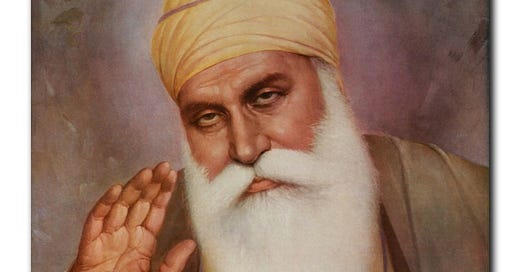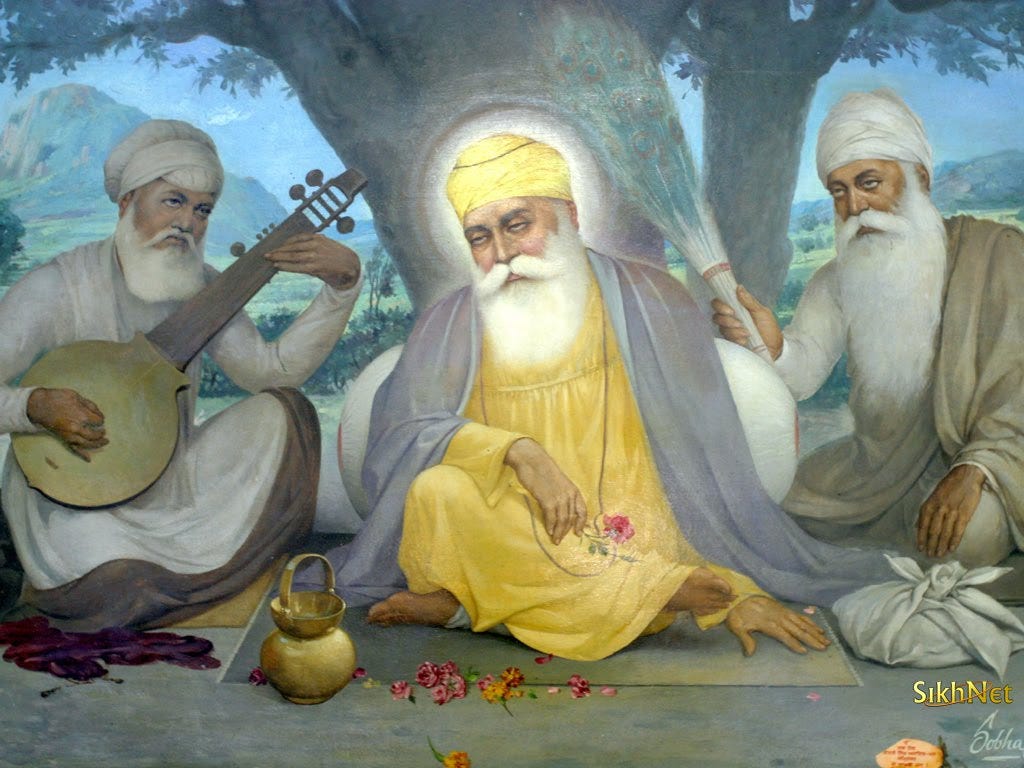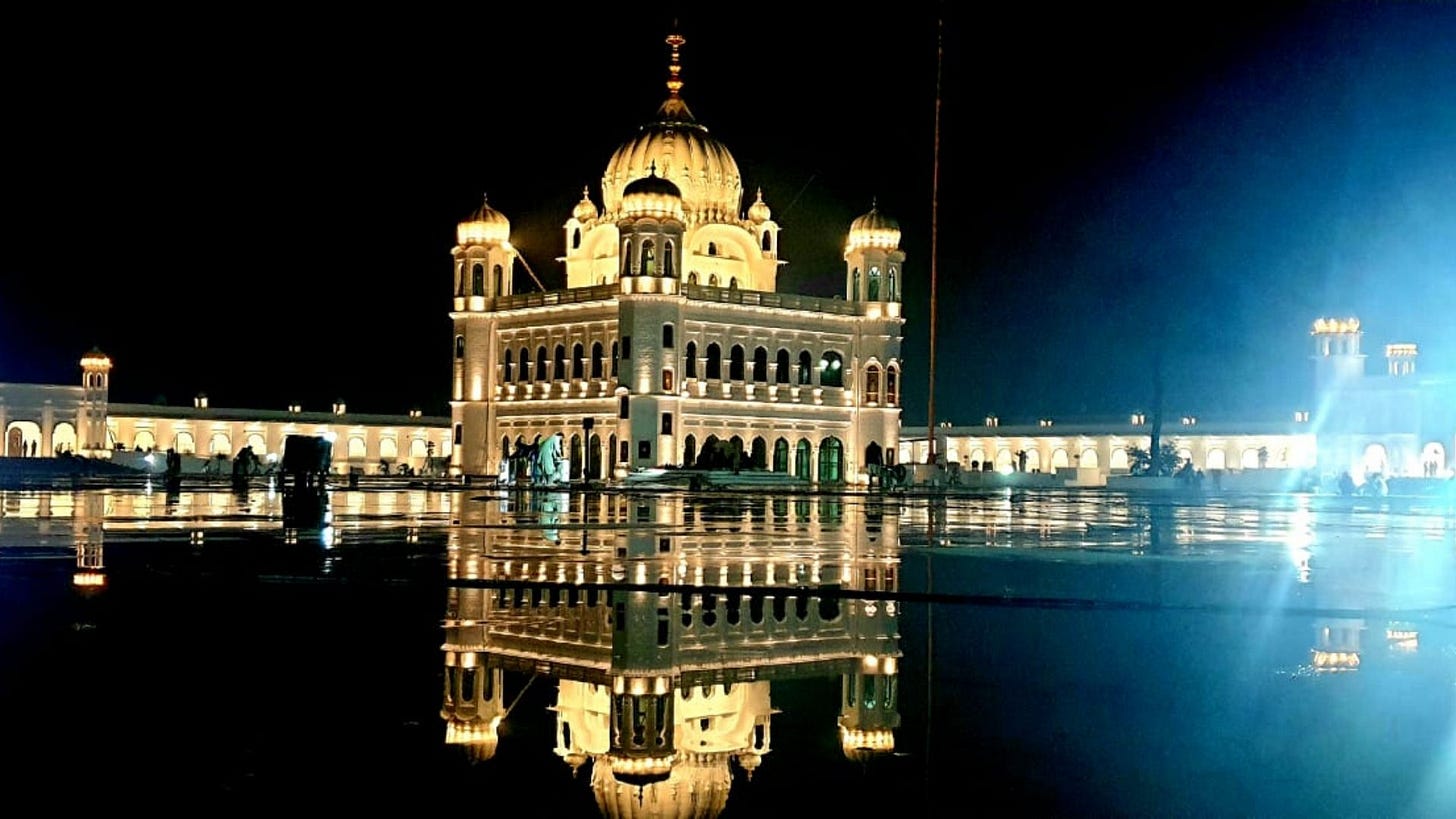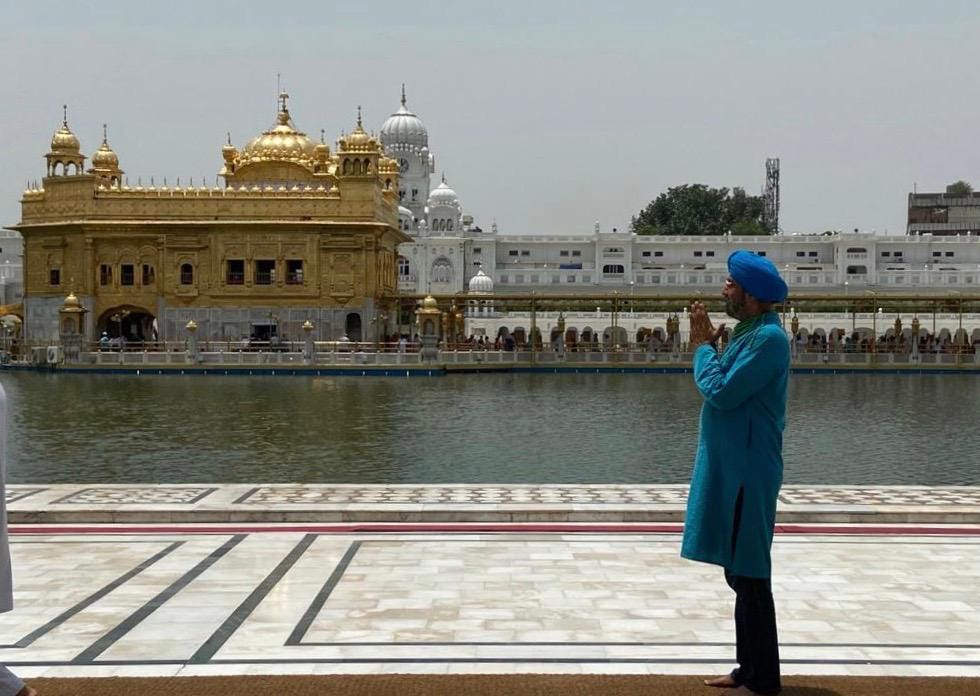555th Birth Anniversary of Guru Nanak Dev Ji: Celebrating a Legacy of Enlightenment and Universal Harmony
The Enlightened Journey of Guru Nanak Dev Ji: Focus on his verses dedicated to the Farmer and Farming.
Early Life and Spiritual Awakening
As we celebrate the 555th Birth Anniversary of Guru Nanak Dev Ji today, we delve into the profound journey of a spiritual master whose teachings laid the foundation of Sikhism. Born on 15 April 1469 in Rai Bhoi Ki Talwandi, now called Nankana Sahib, in the present-day Pakistan, Guru Nanak's early life was marked by a deep contemplative nature and a quest for divine truth1. Many influential Sikh scholars believe that Guru Nanak was born enlightened. However, an event deeply etched in Sikh lore is his transformative immersion in the river Bein, near Sultanpur Lodhi in Kapurthla district of Punjab. Emerging after three days, his proclamation, "There is no Hindu, there is no Muslim," was a powerful as well as profound assertion of the universal oneness of humanity and divinity. This episode symbolizes his enlightenment and the beginning of his life's mission to spread the message of Ek Onkar (One God) and the unity of all beings.
The ‘Udasis’: Journeys dedicated to Universal Brotherhood
Guru Nanak Dev Ji's spiritual journeys, known as 'Udasis', spanned over two decades from 1500 to 1521 and saw him traversing diverse landscapes to share his enlightening teachings. Each of these four major odysseys covered distinct regions and carried a unique significance:
First Udasi (1500-1506): This journey primarily covered Eastern India, including places like Assam, Bengal, Odisha, Manipur, and extended into Bengal (including the modern-day Bangladesh). Guru Nanak used this opportunity to engage with the local populace, discussing spiritual and social issues.
Second Udasi (1506-1513): This odyssey took him to the southern parts of India. He travelled to the modern-day Karnataka (Bidar) and some believe as far south as Sri Lanka, disseminating his messages of spiritual unity and social equality.
Third Udasi (1514-1518): In this phase, Guru Nanak ventured northwards, reaching the Himalayan regions, areas of modern-day Nepal, Tibet, and Bhutan. His interactions here were marked by discussions on meditation, spiritual practices, and the nature of God.
Fourth Udasi (1519-1521): This journey was westward, leading him to the Middle East. He visited sacred Islamic sites, including Mecca and Baghdad2, engaging in dialogues that emphasized the oneness of God and the brotherhood of all humans.
In these travels, accompanied by his faithful companions, Bhai Mardana, a Muslim, and Bhai Bala, a Hindu, Guru Nanak Dev Ji transcended religious and cultural boundaries, promoting a message of universal love, equality, and the unity of mankind. His interactions with people of different faiths and cultures across these regions were instrumental in challenging prevailing societal norms and advocating a vision of a harmonious, unified world. These Udasis stand as a testament to his dedication to dissolving religious divides and fostering a spirit of universal brotherhood.
Compositions and Contribution to Sri Guru Granth Sahib Ji
Guru Nanak Dev Ji's compositions, imbued with profound spiritual insight, form a significant part of the Sri Guru Granth Sahib Ji, that was first compiled as the Adi Granth by the Fifth Nanak, Sri Guru Arjan Dev Ji. Significantly, the Japji Sahib, which is recited as a morning prayer, along with the Mool Mantar, the foundational doctrine of Sikhism, beautifully encapsulate the core principles of Guru Nanak Dev Ji's teachings. The Japji Sahib, with its deep philosophical content, guides seekers on the path to understanding the nature of God, the universe, and the human soul. The Mool Mantar, with its opening phrase "Ek Onkar" (One God), lays the foundation for the Sikh belief in the singularity and omnipresence of the Divine.
Guru Nanak’s Verses on Farming
The verses from Ang (Page) 595 of the Sri Guru Granth Sahib Ji, penned by Guru Nanak Dev Ji, though seemingly alluding to farming, are rich in metaphorical and spiritual meaning. Here they are in Gurmukhi, along with their transliteration and line-by-line English translation:
Gurmukhi: ਮਨੁ ਹਾਲੀ ਕਿਰਸਾਣੀ ਕਰਣੀ ਸਰਮੁ ਪਾਣੀ ਤਨੁ ਖੇਤੁ ॥
Transliteration: Man hālī kirsāṇī karṇī saram pāṇī ṯan kẖeṯ.
Translation: Make your mind the farmer, good deeds the farm, effort/ labour the water, and your body the field.Gurmukhi: ਨਾਮੁ ਬੀਜੁ ਸੰਤੋਖੁ ਸੁਹਾਗਾ ਰਖੁ ਗਰੀਬੀ ਵੇਸੁ ॥
Transliteration: Nām bīj sanṯokẖ suhāgā rakẖ garībī ves.
Translation: Let the Lord's Name be the seed, contentment the plow, and your humble dress the fence.Gurmukhi: ਭਾਉ ਕਰਮ ਕਰਿ ਜੰਮਸੀ ਸੇ ਘਰ ਭਾਗਠ ਦੇਖੁ ॥੧॥
Transliteration: Bẖā▫o karam kar jammsī se gẖar bẖāgaṯẖ ḏekẖ. ||1||
Translation: Doing deeds of love, the seed shall sprout, and you shall see your home flourish. ||1||
The Essence of These Verses
These verses by Guru Nanak Dev Ji are profound in their spiritual and ethical teachings. They employ the metaphor of agriculture to explain the cultivation of the human soul and ethical life. The mind is likened to a farmer, implying that it should be engaged in cultivating good actions and virtues. The body is compared to a field, suggesting that it should be used for performing righteous deeds. The seed sown in this field is the Naam, or the remembrance of God, highlighting the central place of divine remembrance in Sikh spirituality. Contentment is described as the plow, indicating that true satisfaction and peace are achieved through spiritual practice and ethical living. Hard toil and humility are likened to water and a fence, respectively, emphasizing their importance in protecting and nurturing the spiritual life.
Finally, the fruits of these efforts are seen in the flourishing of one's 'home' – a metaphor for the self or the soul. The emphasis is on deeds of love, suggesting that actions performed with love and compassion have a transformative effect on the individual and their environment. Through these verses, Guru Nanak Dev Ji conveys a powerful message about the importance of living a life grounded in spirituality, ethical conduct, and humility, and the transformative power of love and remembrance of the Divine.
Three years ago, at the peak of the Farmers' Agitation, I recorded a video on the eve of the Gurpurab, capturing my humble interpretation of these very verses. You may wish to double-click to view it.
Life in Kartarpur Sahib
After completing his Udasis, Guru Nanak Dev Ji settled in Kartarpur, located on the right bank of the River Ravi in what is now Pakistan, around 1522. This tranquil place became his abode for the last 17 years of his life on earth. In Kartarpur, he founded a dynamic commune where spiritual practice and daily life were interwoven with remarkable harmony. His active participation in farming during this era not only underscored the nobility of labour but also established a model for community service and the sharing of resources.
In this idyllic setting, Guru Nanak Dev Ji continued to exemplify and teach the values of simplicity, equality, and devotion. His earthly journey came to a close on 22nd September 1539. A few days prior to his ascension to the heavenly abode, in a significant move that underscored the meritocratic nature of spiritual leadership in Sikhism, Guru Nanak Dev Ji appointed Bhai Lehna as his successor, bestowing upon him the name Guru Angad Dev Ji. This decision, favoring spiritual devotion and understanding over familial ties, marked the passing of the Guruship to Guru Angad Dev Ji, thus overlooking his own sons. This pivotal moment set a precedent for the Sikh tradition, where Guruship was based on spiritual merit rather than lineage.
Kartarpur Sahib Today
Kartarpur Sahib, as it stands today, is more than a mere physical location; it symbolizes Guru Nanak's vision of a society rooted in equality, communal harmony, and unwavering devotion to God. The establishment of the Kartarpur Corridor, a significant initiative allowing pilgrims from India to visit this sacred shrine for day-long visits without the need for a formal visa, has furthered the accessibility of this holy site. This corridor serves as a bridge, not just between two nations but also as a link connecting devotees to the profound teachings and legacy of Guru Nanak Dev Ji.
Universal Message of Peace and Harmony
Guru Nanak Dev Ji's life and teachings resonate with a timeless message of peace, harmony, and the unity of humanity under one Divine. His emphasis on the equality of all beings, regardless of caste, creed, or gender, and his advocacy for a life of truth, compassion, and community service continue to inspire millions worldwide. As we celebrate his birth anniversary, we are reminded of his profound teachings and their relevance in today's world - a world where his message of oneness, love, and social justice is more pertinent than ever.
Closing Thoughts
The 555th Birth Anniversary of Guru Nanak Dev Ji invites us to reflect on his spiritual legacy and to embody his teachings in our lives. His life, a beacon of divine light and wisdom, guides us on the path of righteousness, unity, and universal brotherhood. Let us embrace his teachings, carry forward his message of universal love and peace, and continue to be inspired by his visionary life.
I recorded the following video four years ago.
It is significant to note the Shiromani Gurdwara Parbandhak Committee's (SGPC) decision in 2003 to adopt the Nanakshahi calendar, which officially designated April 15th as the date for Guru Nanak Dev Ji's Gurpurab. Despite this, an overwhelming request from the Sikh community prompted the SGPC to continue observing Gurpurab on the traditional date, aligned with the lunar calendar, falling on the full moon day (pooranmashi) following Diwali. The SGPC's acquiescence to this request underscores the profound interplay of historical traditions, cultural practices, and community consensus in shaping and defining religious observances. This decision reflects the dynamic nature of faith and the importance of community sentiment in the practice of religious traditions.
https://www.facebook.com/share/r/65cwTYSsTby6Q7vv/?mibextid=UalRPS
Facebook Video Reel by Bhai Sant SIngh Ji Maskeen, regarding Guru Nanak Dev Ji’s visit to Baghdad.








Guru Sahab's journey to south extended way far. There is a historic Gurudwara sahab in Rameshwaram where arte facts from Guru Sahab's visit are preserved. This Gurudwara sahab is looked after by one Granthi deputed by Chennai Gurudwara. He is the only Sikh in Rameshwaram island. Nearest Sikh family, according to him, is in Madurai, some 250KMs from Rameshwaram. Also, Chennai has some 250 prospering Sikh families and one Gurudwara sahab at GN Chetty Road in T Nagar. There is one more in Tambaram army complex, managed by Army personnel.
🙏🏻🙏🏻🙏🏻🪯🪯🪯😇😇😇